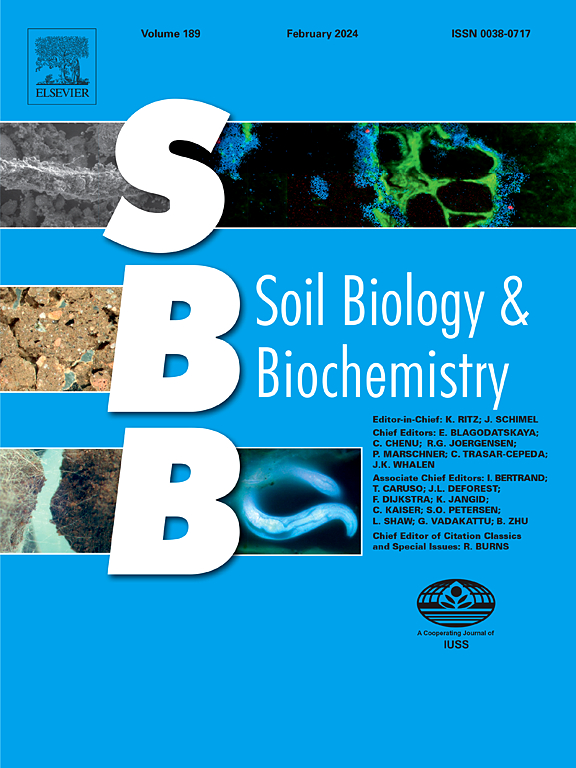Microplastics in agricultural soils: The role of soil texture in modulating oxygen diffusivity and soil respiration
IF 10.3
1区 农林科学
Q1 SOIL SCIENCE
引用次数: 0
Abstract
The presence of microplastics (MPs) in soils impacts nutrient cycling and soil respiration. However, the mechanisms underpinning the direction and magnitude of these effects on soil are uncertain. We hypothesized that the presence of MPs affects pore connectivity, leading to changes in oxygen (O2) diffusivity and soil respiration. Furthermore, we anticipated that the magnitude of the effects would be dependent on both soil texture and MPs morphology. 1 % (w/w) PET MPs fibers (500 μm length) and fragments (125–250 μm) were spiked into rhizotrons filled with either clay or sandy loam soils. O2 diffusivity differences were determined in microcosm using an oxygen-free chamber. The O2 concentration in the soil was also measured in optimal conditions for respiration. O2 diffusivity and concentration were measured using optode imaging. Respiration was estimated from cumulative CO2 and changes in the size of the water-extractable carbon pool. Adding MPs decreased O2 concentration in the sandy loam soil (167.4 ± 6.1 mg L−1 air), with a greater reduction observed for fragments (15 %) compared to fibers (12 %). Soil respiration decreased by 40 % in both fragment and fiber treatments in alignment with the reduction in oxygen concentration. Conversely, in the clay soil, the addition of fibers and fragments resulted in a 13 and 7 % increase in O2 concentration compared to the control (177.9 ± 3.8 mg L−1 air). Both changes in oxygen concentration and diffusivity, show a similar response to MPs for the two soils. These findings indicate that the effects of MPs on soil respiration are likely driven by changes in O2 dynamics. However, the MPs' impact on O2 dynamics depends on soil particle size distribution. Future research should consider MP size, morphology, and soil particle distribution interactions to assess MPs' impacts on soil functions.
农业土壤中的微塑料:土壤质地在调节氧气扩散率和土壤呼吸中的作用
土壤中微塑料的存在影响养分循环和土壤呼吸。然而,支撑这些对土壤影响的方向和程度的机制是不确定的。我们假设MPs的存在会影响孔隙连通性,导致氧气(O2)扩散率和土壤呼吸的变化。此外,我们预计影响的大小将取决于土壤质地和MPs形态。将1% (w/w)的PET MPs纤维(500 μm长度)和碎片(125 ~ 250 μm)刺入填充粘土或砂壤土的根管中。在无氧室中测定微观环境下的氧扩散率差异。在最佳呼吸条件下也测量了土壤中的氧浓度。利用光电成像技术测量O2扩散率和浓度。通过累积CO2和水可提取碳库大小的变化来估计呼吸作用。添加MPs降低了沙质壤土(167.4±6.1 mg L-1空气)中的O2浓度,其中碎片(15%)比纤维(12%)降低得更大。随着氧浓度的降低,碎片处理和纤维处理的土壤呼吸均下降了40%。相反,在粘土中,与对照(177.9±3.8 mg L-1空气)相比,纤维和碎片的添加导致O2浓度增加了13%和7%。两种土壤的氧浓度和扩散系数的变化对MPs的响应相似。这些发现表明,MPs对土壤呼吸的影响可能是由氧动力学的变化驱动的。然而,MPs对O2动态的影响取决于土壤粒度分布。未来的研究应考虑MPs的大小、形态和土壤颗粒分布的相互作用,以评估MPs对土壤功能的影响。
本文章由计算机程序翻译,如有差异,请以英文原文为准。
求助全文
约1分钟内获得全文
求助全文
来源期刊

Soil Biology & Biochemistry
农林科学-土壤科学
CiteScore
16.90
自引率
9.30%
发文量
312
审稿时长
49 days
期刊介绍:
Soil Biology & Biochemistry publishes original research articles of international significance focusing on biological processes in soil and their applications to soil and environmental quality. Major topics include the ecology and biochemical processes of soil organisms, their effects on the environment, and interactions with plants. The journal also welcomes state-of-the-art reviews and discussions on contemporary research in soil biology and biochemistry.
 求助内容:
求助内容: 应助结果提醒方式:
应助结果提醒方式:


